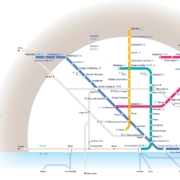Metro

The controversial plan to extend the Lisbon metro by constructing a circle line – joining the existing yellow and green ones – has finally moved forward thanks to a solid financial injection of € 83 million from the EU’s Cohesion Fund. Works – which will link Rato to Cais Sodré and São Sebastião to Campo Ourique, including new stations in Estrela and Santos – should move forward in phases up to 2024.

The Estrela station will be built at the top of the Calçada da Estrela, 54 meters below ground level and be twelve meters lower than the Ameixoeira station, currently Lisbon’s deepest metro station.
According to Brussels, the improved public transport service will not only reduce CO2 emissions with around 5000 tons per year but also contribute to the creation of employment, much needed at the time of the pandemic.

The € 215 million project nearly didn’t make it when Parliament supported at the beginning of this year a proposal by PAN (People, Animals and Nature party) to suspend the plan of the socialist government, as it wasn’t wide-ranging enough. PAN – backed by almost all opposition parties – wanted a much larger expansion, including outlying areas in the Lisbon Metropolis, like Loures, Sintra and Cascais.

Construction of the first leg of the Portuguese metro started 65 years ago, in August 1955. The initial line consisted of 6,5 kilometres, had 11 stations and two-carriage trains.
the Lisbon Metro currently consists of four lines and 56 stations.

Furthermore, this summer, the municipalities of Lisbon, Loures and Oeiras have jointly decided to construct a light rail along the Tagus river, linking Alcântera to Cruz Quebrada and Santa Apolónia to Sacavém. The estimated investment totals € 490 million. The new line will have a total length of 25 kilometres and will be connected to the existing riverside, tram and train lines to the west and the north of the capital.

Extension of the public transport facilities not only benefits the environment by reducing air pollution from cars but is supposed to lead as well to a reduction of the urban mortality rate in pedestrians. A study by the ETSC (European Transport Safety Council) showed that between 2010 and 2019 nearly 1400 pedestrians died on Portuguese streets, placing the country in an unwanted fifth place among 28 European states.
Stay healthy Fique saudável (pic público/sapo)




